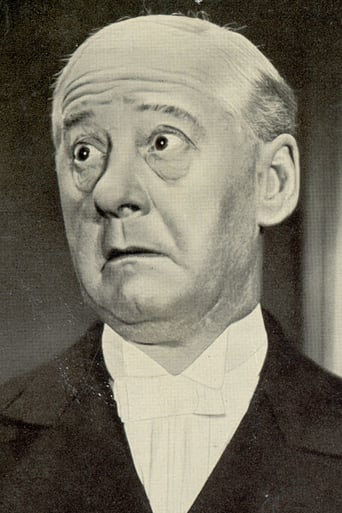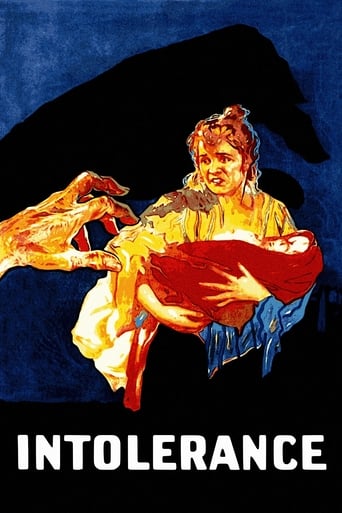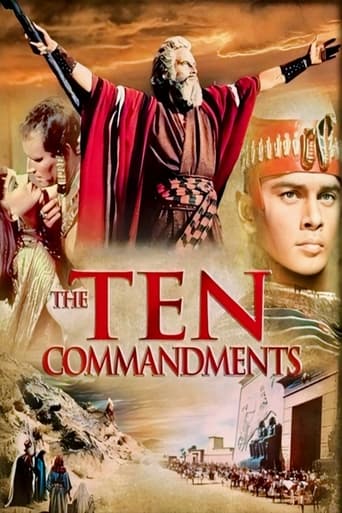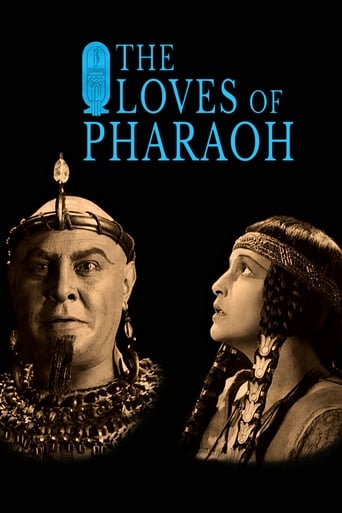
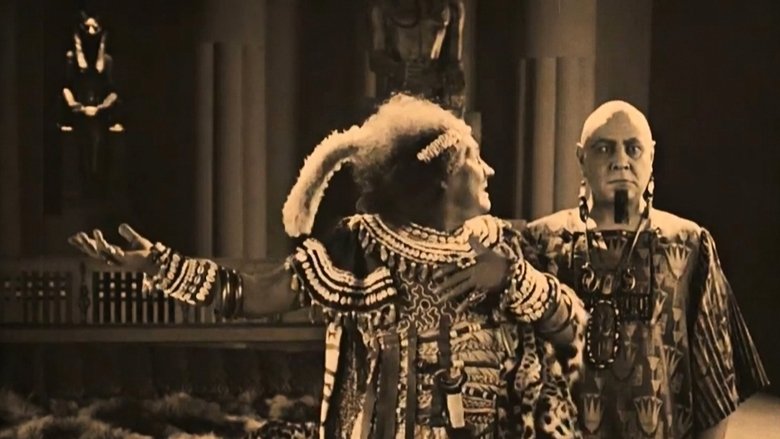
The Loves of Pharaoh (1922)
The Ethiopian King offers his daughter to a powerful Pharaoh to secure peace between the two countries.
Watch Trailer
Cast


Similar titles
Reviews
The Loves of Pharaoh (1922) *** (out of 4)Imressive German epic from Ernst Lubitsch about the war that breaks out when an Ethiopian King (Paul Wegener) offers his daughter to a Pharaoh (Emil Jannings) but she then falls his love with one of his servants. THE LOVES OF PHARAOH is a very impressive silent thanks in large part to the wonderful visuals and mammoth sets, which certainly make this rank right up there with the work that D.W. Griffith and Cecil B. DeMille were doing around this same time. I think the most impressive thing is how massive the sets are and how many extras were used during the battle sequences. There are some moments here that make you want to pause the film just so you can get a better look of everything that's going on. The greatest sequence comes towards the end of the picture when we see a giant hill where the camera is pointing straight at it. The action then starts and you see hundreds of people at the bottom of the hill fighting with hundreds more coming from over the hill, down in and into the battle. These scenes are just so big that you can't help but wonder how long it must have taken just to get one shot. The performances are another major plus with Jannings doing an excellent job with the villain. I thought he was extremely believable in the part and he never goes overboard with his madness. I also really enjoyed seeing Wegener here as the "look" from THE GOLEM is still here. Lubitsch does a masterful job at building up all the action but I think the film's one flaw is the screenplay. I never really cared about any of the characters and I found the story to be a tad bit too dull for its own good. Several portions of the film are still missing so photos are put in the missing segments place.
TCM presented a beautiful print of Ernst Lubitsch's Egyptian epic THE LOVES OF PHAROAH (1922). Released by Paramount in the US, the film was Lubitsch's last feature in his home country of Germany before setting up camp in Hollywood. (That's another story all together.) The "Lubitsch Touch" in his historically-based epics, such as CARMEN, MADAME DUBARRY, SUMURUN, or ANNA BOLEYN, is the director's ability to present us with the overwhelming sight of the plight of the crowd and then gradually direct our attention to a personal drama taking place within the epic sweep of time and destiny. (He does so more genuinely than DeMille, who seemed to have imitated this approach.) Then, of course,there are the sexual situations, the uncontrollable attractions, and the inevitable rejections that determine the fates of the characters, a theme continued into the director's sophisticated comedies and, later, witty musicals that followed this film. LOVES OF PHAROAH has stunning visual moments both large and small: the crowds working, revolting, being manipulated by rulers to the turning of Emil Jannings to a wall and dropping an outstretched hand, showing his reluctant realization of the futility of his affections. The film is deliberately paced but never draggy. Though there are moments of regret (the depiction of the Ethiopians is particularly stereotyped and inconsistent), this foray into Arabian exotica is a dramatic improvement over the stilted presentations seen in SUMURUN from a couple of years before. With THE LOVES OF PHAROAH, Lubitsch reaches the apex of his epic years (though THE PATRIOT may have reached greater heights, though we'll never know until a print is found).
"Das Weib Des Pharao" (1922) has been one of the most anticipated silent film restorations released in this modernen year. September saw the long awaited premiere of the film which was superbly restored thanks to the efforts of different European institutions. This little known Herr Ernst Lubitsch movie of his German period is now available to the joy of silent film fans around the world. "Das Weib Des Pharao" was the last film directed by Herr Lubitsch before he departed to Amerika where his career was very different in terms of artistic style and goals. Certainly "Das Weib Des Pharao" is characteristic of his work during his Teutonic epoch.First of all, the film is "kolossal": magnificent décors, lavish and gorgeous costumes, crowd scenes astonishing in the number of extras employed. This huge production and Herr Lubitsch's mastery transports the audience back to ancient Egypt.But "Das Weib Des Pharao", spectacular art direction and staging notwithstanding, is also a tormented love story, intimate and nuanced and combining seamlessly with the more spectacular dimension of the plot, the war between the king of Ethiopia Herr Samlak ( Herr Paul Wegener ) and the pharaoh Herr Amenes ( Herr Emil Jannings ). The conflict begins when the king of Ethiopia invades Egypt because his daughter, Frau Makeda ( Frau Lyda Salmonova ) has been rejected by Herr Amenes due to his infatuation with Frau Theonis (Frau Dagny Servaies), namely slave of Frau Makeda. To complicate matters, Theonis is in love with Herr Ramphis (Herr Harry Liedtke). Theonis, against her will, becomes the Queen of Egypt. Tragedy follows for all.This Herr Von was absolutely fascinated during the scenes between the pharaoh Amenes and the beautiful slave Theonis; Jannings' restrained performance shows all the pain and longing of unrequited love as he vainly tries to win her favour. Some of the scenes are in lovely chiaroscuro; the cinematography by Herr Alfred Hansen und Herr Theodor Sparkhul is brilliant."Das Weib Des Pharao" is for this German count a very special Lubistch oeuvre, combining the characteristics of a "kolossal" picture with intimate melodrama. None of the Lubitsch wit is on hand and there is certainly no humor in the film to lighten the story. It remains serious all the way through and is without concessions, making it a very unique Lubitsch film whose rediscovery is a great gift to lovers of the Silent Era. And now, if you'll allow me, I must temporarily take my leave because this German Count has an appointment with his beautiful Teutonic slave instead of one of his fat German heiresses.
I viewed an incomplete print of 'The Wife of the Pharaoh' that was reconstructed (from several sources) by Stephan Droessler of the Film Museum in Munich. Even in remnant form, this is a phenomenal film: an epic piece of film-making, with 6,000 extras and elaborate sets. 'The Wife of the Pharaoh' is the nearest Ernst Lubitsch came to making a film like 'Metropolis'.'The Wife of the Pharaoh' was released in 1922, the same year that Englishman Howard Carter unsealed Tutankhamen's tomb ... but at this time, much of the most important work in Egyptology was being done by Germans, and German interest in ancient Egypt was high indeed. This film is set in dynastic Egypt (Middle Kingdom, by the look of it) ... and the sets, costumes and props are vastly more convincing than anything done by Hollywood in this same era in films such as 'King of Kings', "Noah's Ark" and the Babylonian sequences of 'Intolerance'.There are of course a few errors in this movie: the elaborate Double Crown symbolising the two kingdoms of Egypt is the proper size and shape, yet the actors heft it about so easily that it's clearly a prop made from some improbably light substance. The pharaoh receives papyrus scrolls bearing messages written in hieroglyphics; this is wrong (the messages would have been written in hieratic, and the king would probably require a scribe to read them on his behalf), yet somebody made a commendable effort to use the proper hieroglyphics ... which is more than Universal Studios bothered to do in any of those 1930s mummy flicks.Emil Jannings gives an operatic performance as the (fictional) king Amenes. The king of the Ethiopians (Paul Wegener), hoping to make peace with Egypt, offers his daughter Theonis to become the wife of Amenes.But Theonis falls in love with Ramphis, the handsome son of the king's adviser Sothis. (Ramphis wears a hairdo stolen from Prince Valiant: one of the few really ludicrous errors in this film.) Amenes sentences the lovers to death, then offers to spare Ramphis from execution (sentencing him to hard labour for life) if Theonis will consent to love only Amenes.There are some truly spectacular scenes in this film, very impressive even in the partial form which I viewed. Paul Wegener gives a fine performance as Samlak, king of the Ethiopians, but he looks like he escaped from a minstrel show: to portray an Ethiopian, Wegener wears blackface and body make-up, and a truly terrible Afro wig. And since his daughter Theonis is presumably also an Ethiopian, why is she white?There are fine performances by Lyda Salmonova as a (white) Ethiopian slave-girl (the nearest equivalent to Aida in this operatic story) and by Albert Bassermann as the adviser who is spitefully blinded at the pharaoh's order. Theodor Sparkuhl's camera work is superlative, as always, and the art direction is brilliant. Although I viewed only an incomplete version of this film, I've read a surviving screenplay; the script (with some lapses in logic) is definitely the most ridiculous part of this film. But the favourable aspects of this movie very definitely outweigh its flaws. I'll rate 'The Wife of the Pharaoh' 9 out of 10.



